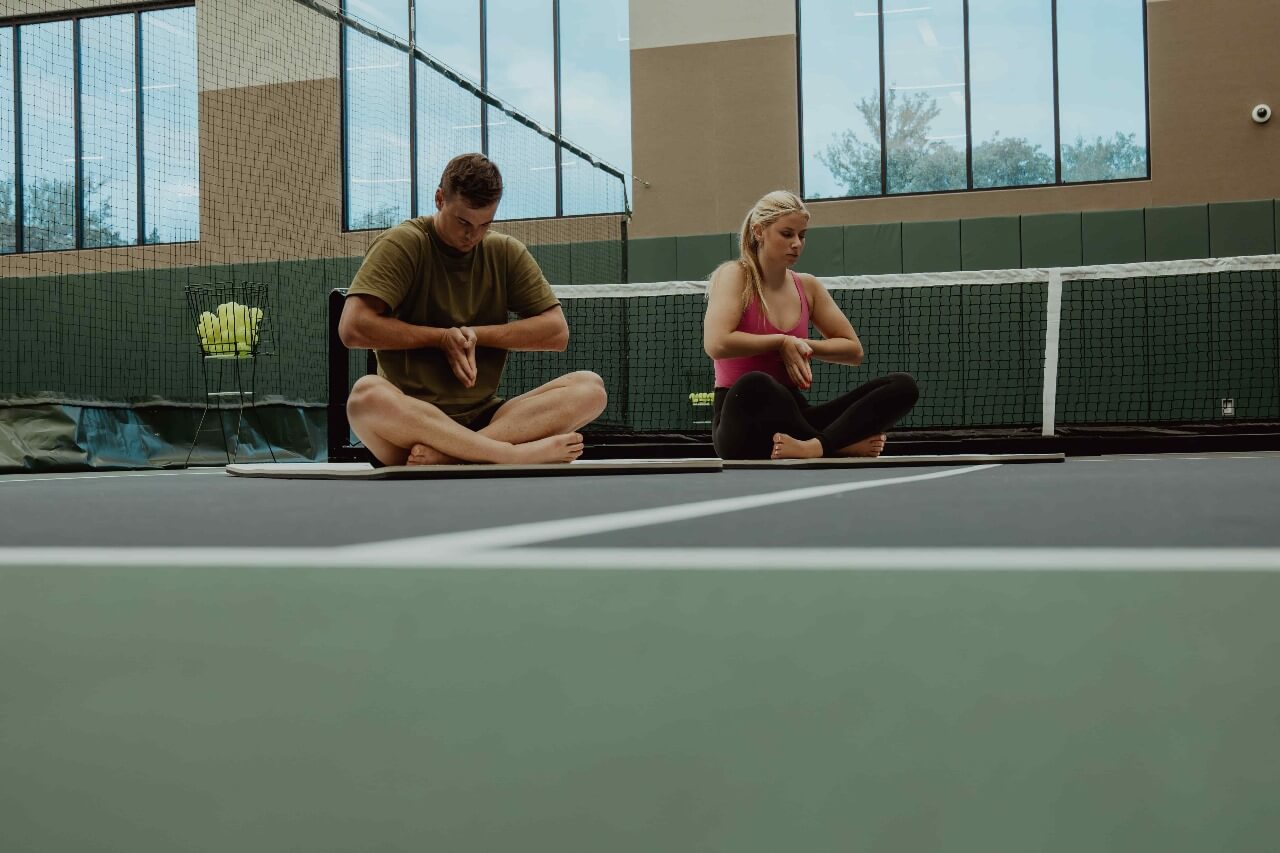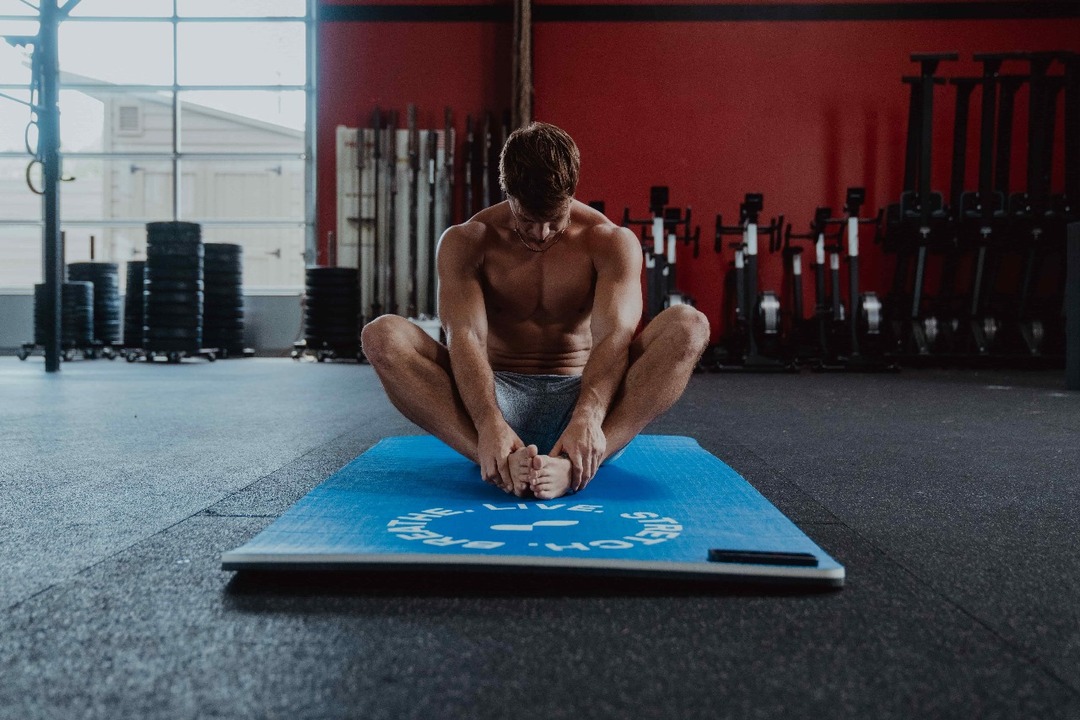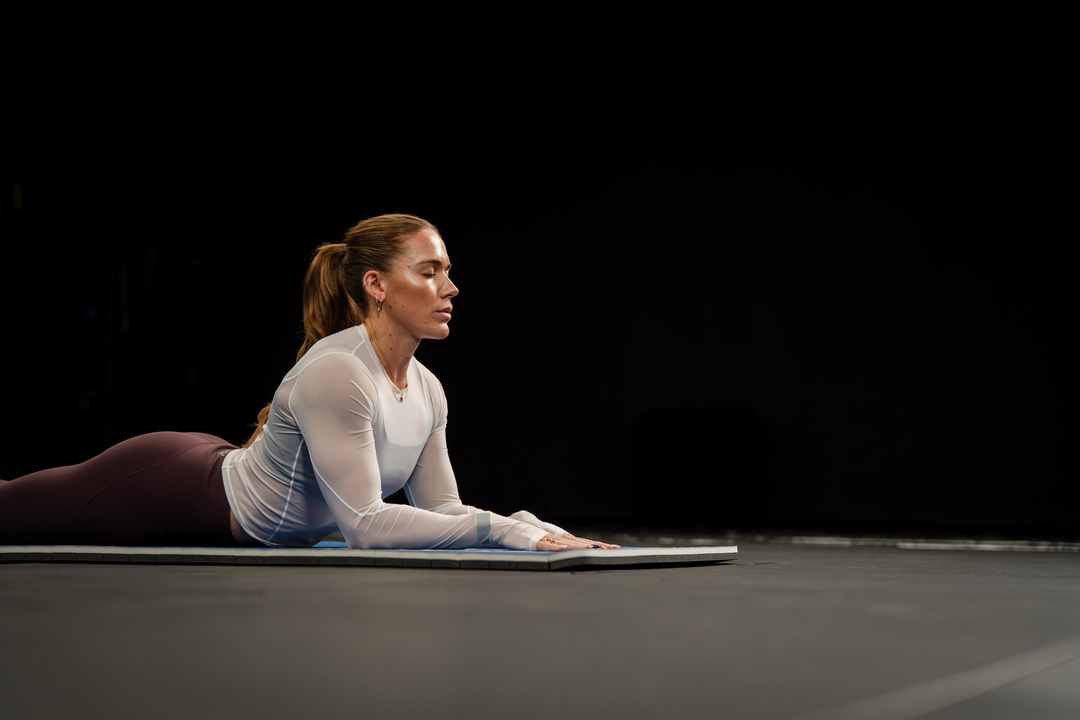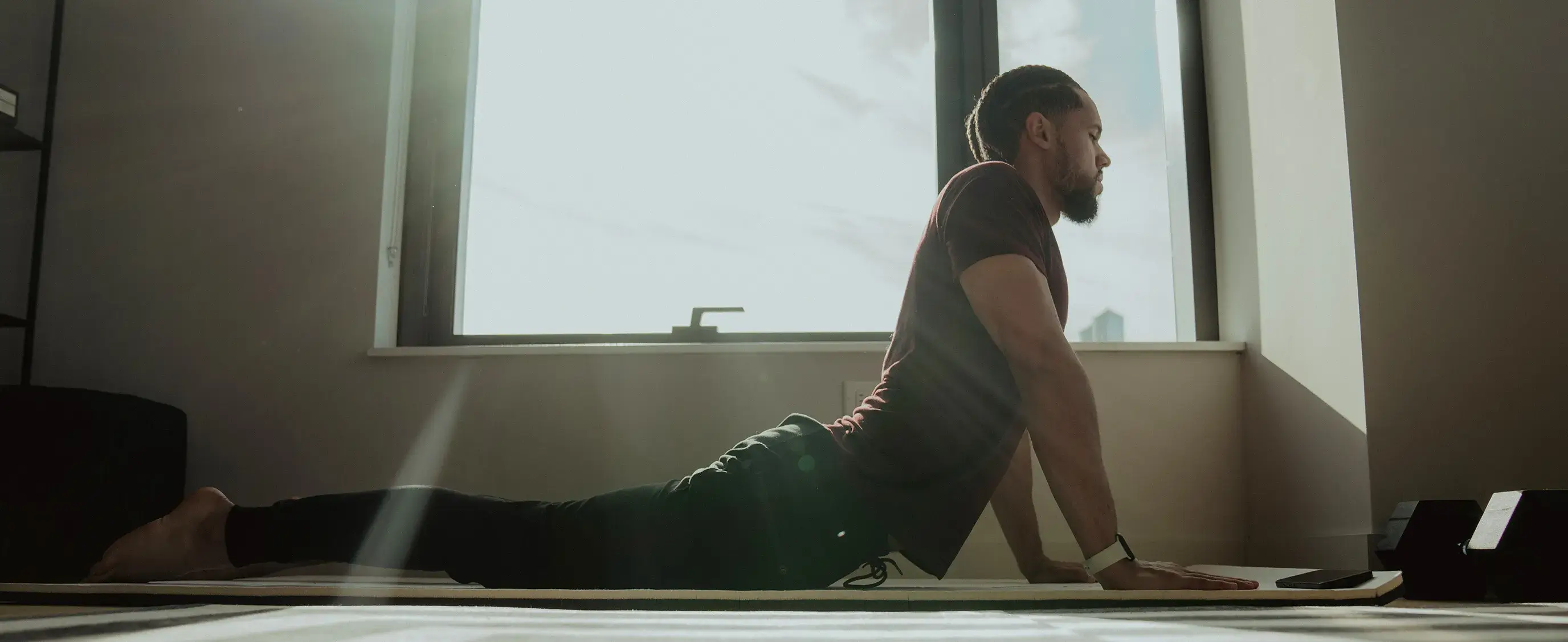Cervical radiculopathy can cause pain and dysfunction that interfere with daily life. You might notice sharp or burning pain in your neck, shoulder, or arm that aches or tingles, especially with certain movements. Nerve pain can make it difficult to turn your head or find a comfortable sleeping position. Cervical radiculopathy exercises improve neck and nerve function to help alleviate pain, regain mobility, and improve quality of life. This article will help you get started with effective, mobility exercises.
Pliability's mobility app offers valuable guidance to help you quickly alleviate neck and nerve pain and regain mobility through cervical radiculopathy exercises. With simple video demonstrations and an easy-to-follow interface, the app makes improving your quality of life easy through effective, targeted exercises.
What is Cervical Radiculopathy (Pinched Nerve in the Neck)?
.jpeg)
Cervical radiculopathy, also known as a pinched nerve, is a condition that results in neurological dysfunction caused by compression and inflammation of any of the nerve roots of your cervical spine (neck). Neurological dysfunction can include:
- Radiating pain
- muscle weakness
- Numbness
Cervical comes from the Latin word cervix, which means neck. In the case of cervical radiculopathy, the issue is in your neck, not your cervix. The cervix, the narrow passage forming the lower end of the uterus, is called so because it’s a neck-like passage.
What Causes Cervical Radiculopathy?
Cervical radiculopathy happens when a nerve root in your neck (cervical spine) becomes compressed (pinched) and inflamed. This compression has two main causes:
- Degenerative changes in your spine as you age (cervical spondylosis).
- A herniated (bulging) disk in your neck.
Typical signs and symptoms may include, but are not limited to:
- Numbness
- Burning
- Tingling Muscle weakness
- Pain in the neck or arms (radicular pain)
- Loss of range of motion.
Two important things to note:
- These signs and symptoms occur along a continuum. For example, one person may present with no noticeable muscle weakness, while another may demonstrate significant atrophy of the affected muscles.
- Depending on the nerve affected, the distribution of pain or sensory changes is often shown following a predictable pattern. This is not always the case; unbeknownst to most people, symptoms often present in the scapular or rhomboid region.
What is the Cervical Spine?
Your spine (backbone) is the long, flexible column of bones that protects your spinal cord. It begins at the base of your skull and ends in your tailbone at your pelvis. Your cervical spine is the neck region of your spine. It consists of seven bones (C1-C7 vertebrae). Vertebrae help protect your spinal cord from injury. Between your vertebrae and your spine are round cushions called disks. They have soft, gel-like centers and a firmer outer layer, like a jelly doughnut. These disks provide cushioning and flexibility for your vertebrae.
Your spinal cord acts like a highway that connects the nerves located all over your body to your brain so that your brain can send signals and communicate with the rest of your body. A nerve root is the initial segment of a nerve that leaves your spinal cord. It’s the root of the nerves that extend out to other parts of your body. Different nerve roots along your spine extend to different parts of your body. When a nerve root becomes pinched, it can affect the nerves attached. This is why a pinched nerve (cervical radiculopathy) in your neck can cause pain that radiates down your arm.
Who Does Cervical Radiculopathy Affect?
Anyone can get cervical radiculopathy, but it’s more common in adults. Cervical radiculopathy caused by a herniated disk is more common in people up to 50 years old. Cervical radiculopathy caused by disk degeneration is more common in people in their 50s and 60s.
People in their 70s or older tend to develop cervical radiculopathy due to foraminal narrowing caused by arthritis. The foramen is the bony hollow opening between vertebrae through which spinal nerve roots travel.
How Common is Cervical Radiculopathy?
Cervical radiculopathy is common. It affects approximately 85 out of 100,000 people, with the condition being more prevalent in individuals over 50, as indicated by a population-based study. In over half of cervical radiculopathy cases, the C7 nerve root is affected, and approximately a quarter of cases affect the C6 nerve root.
Related Reading
- Ankle Mobility Exercises
- Shoulder Mobility Exercises
- Hip Mobility Exercises
- How To Improve Flexibility
- Thoracic Mobility Exercises
- Stretch Before Or After Workout
- Wrist Mobility Exercises
- Mobility Exercises For Beginners
- Best Stretching Routine
- Back Mobility Exercises
- Lower Body Mobility Exercises
- Leg Mobility Exercises
- Mobility Exercises For Athletes
17 Cervical Radiculopathy Exercises
.jpeg)
1. Neck Flexion and Extension
These movements improve ROM and are especially helpful if you have a forward head posture from working on a computer, gaming, or texting for long periods.
- Stand tall with your feet hip-width apart and arms to your sides.
- Keep your abdominal muscles tight and your shoulders relaxed throughout these stretches.
- Slowly drop your chin to your chest and hold for 15-20 seconds.
- Return to the starting position.
- Slowly look up the ceiling as far as possible, allowing your chin to tilt up.
- Hold for 5-10 seconds and return to the starting position.
- Perform 2-4 repetitions.
2. Lateral Neck Flexion
This exercise helps ease pain and stiffness and increase ROM.
- Stand tall with your feet hip-width apart and arms to your sides.
- Gently bend your head to the right, bringing your right ear to meet your right shoulder.
- Hold for 5-10 seconds and return to the starting position.
- Repeat this stretch on the left side.
- Complete ten repetitions on each side.
3. Chin Tuck
Chin tucks, or cervical retraction, help increase the mobility of the neck.
- Start in a seated position with your shoulders back and down.
- As you look forward, slowly draw your head backward along a horizontal plane until your neck is over your spine.
- Hold for 5-10 seconds and relax.
- Repeat 15-20 times.
4. Cervical Traction
This move uses gravity to open the cervical spine and reduce joint pressure.
- Sit in a chair with your back supported on a chair.
- Place a rolled-up sheet or an exercise band around the back of your neck.
- Pull the ends of the sheet up to the forehead, holding the ends close to mine.
- Bend your neck down as you gently pull on the ends of the sheet until you feel a gentle neck distraction.
- Hold each position for 15-30 seconds, and repeat up to 5 times.
5. Side Tilts
Neck tilts are a great exercise for cervical radiculopathy caused by arthritis or stenosis. To perform this exercise, sit in a chair and slowly tilt your neck to one side, bringing your ear toward your shoulder.
- Hold the position for three seconds, then return to the upright, neutral position.
- Repeat ten times.
You can repeat the side neck tilt for the other side, or your therapist may have you bend in only one direction to relieve a pinched nerve in your neck. They may also have you tilt your neck as forward as possible.
6. Isometric Holds
Therapy for cervical radiculopathy may also include isometric holds, a type of exercise in which you hold the motion in your neck muscles still. They work on the basis of resistance. For example, you can hold your neck in a tilt for 30 seconds with your hand pressing against it before releasing the position. You can do so while standing or sitting in a chair.
Isometric holds target a specific spot, which makes them a good choice if you've had surgery or need to recover from injury. Ask your physical therapist if isometric holds for your shoulders and arms may help with the condition, too.
7. Shoulder Circles
Shoulder circles can help relax upper and lower neck muscles and may improve your postural
awareness. To perform the exercise:
- Sit upright in a chair, then slowly lift your shoulders straight to your ears.
- Roll your shoulders backward, pinching your blades behind you as you roll.
- Relax, and then repeat the exercise for ten repetitions.
This exercise can be done several times each day to relax muscles and improve postural awareness.
8. Side to Side Strengthener
Your therapist may recommend this exercise for cervical rotation to improve overall neck mobility. To perform the exercise:
- Sit upright in a chair and turn your head to one side as far as possible.
- Once you are at the end of the range, hold the position for a few seconds, and then return your head to the neutral position.
- Repeat the exercise 10 times to one side and then ten times to the other.
9. Nerve Glides
Nerve glides, also called flossing, is a technique used to relieve nerve tension. These techniques stretch irritated nerves in the arms, which can help decrease compression.
This technique lengthens the median nerve.
- Sit or stand with good posture.
- Extend your arm to the side with your palm up.
- Extend your fingers and bend your neck away from your arm. Hold briefly.
- Repeat 15 times.
10. Walking
Sitting in the same position for long periods, especially with crossed legs, can damage the nerves and muscles. Take frequent walking breaks. Keep the head neutral to get the most out of walking and help ease a pinched nerve. The ears should be level with the shoulders, and the jaw should be loose, not clenched.
11. Shoulder Rolls and Shrugs
Moving the shoulders can help reduce tension in the neck. It can also alleviate some people's headaches with pinched nerves and muscle tightness.
To exercise the shoulders:
- Shrug the shoulders slowly up and down for 30 seconds.
- Rest for a few seconds.
- Roll the shoulders forward and toward the ears, then back down and back, pushing the shoulder blades together.
- Repeat this move for 30 seconds, then reverse the direction.
12. Child’s Pose
Yoga involves slowing the body's movement through a wide range of positions while focusing on engaging each muscle group. It is an ideal low-impact option for people dealing with pain.
Child’s pose, in particular, can be helpful for people with a pinched nerve in the neck. To do Child’s pose:
- Start by sitting on the heels on a mat, with the tops of the feet flat on the floor.
- Learn the body forward until it meets the thighs.
- Extend the arms above the head, with the hands flat on the floor.
- Hold for 30 seconds.
13. Thoracic Extension
A thoracic extension can help to stretch the upper back. To do this stretch:
- Sit in a neutral position in a chair with a backrest.
- Place your hands on the back of your head.
- Arch your chest backward against the backrest.
- Hold the stretch and repeat.
14. Ulnar Nerve Towel Sliders
The ulnar nerve goes from the neck to the hand. It is the nerve responsible for a person feeling pain in the “funny bone.” To use ulnar nerve towel sliders to relieve pinched nerve symptoms, a person can:
- Hold one end of a towel in the hand on the side of the pinched nerve, placing it near the head.
- Let the rest of the towel drop behind the back and grab it with the other hand near the lower back.
- Pull the towel upward with the top hand as far as it will go.
- Pull it back down with the bottom hand.
- Do not hold the stretch at the top or bottom, but keep the arms moving for 30 seconds.
15. Trap Stretch
Your trapezius muscles are in the back of your neck. If they’re too tight, they can compress your spine and nerves. This exercise will loosen these muscles and release trapped nerves.
- Place your right hand under your thigh.
- With your left hand, gently bend your head to the left side.
- Pause for 30 seconds. Repeat 3 times on each side.
16. Prone Head Lifts
- Lie face down on a mat and prop up on your shoulders.
- Let your head hang down so your chin is near your chest.
- Lift your head upward to the neutral position as you tuck your chin.
- Continue lifting your head as you attempt to look up at the sky.
- Hold for five seconds.
- Return down to the head-hanging position.
- Repeat five times, two times a day.
Beyond Flexibility: The Pliability Advantage
Pliability offers a fresh take on yoga tailored for performance-oriented individuals and athletes.
Key features include:
- A vast library of high-quality videos designed to improve flexibility, aid recovery, reduce pain, and enhance range of motion.
- Daily updated custom mobility programs for optimizing their health and fitness.
- A unique body-scanning feature to pinpoint mobility issues
Whether you're limited by pain or movement restrictions, Pliability complements your fitness routine and helps you move better.
Sign up today for a 7-day free trial on iPhone, iPad, Android, or via our website to improve flexibility, aid recovery, reduce pain, and enhance range of motion with our mobility app.
Related Reading
- Golf Mobility Exercises
- Upper Body Mobility Exercises
- Mobility Exercises For Runners
- Can You Over Stretch
- Squat Mobility Exercises
- Functional Mobility Exercises
- Why Stretching Is Important
- Foot Mobility Exercises
- Arm Mobility Exercises
- Hamstring Mobility Exercises
- Elbow Mobility Exercises
- Rotator Cuff Mobility Exercises
- Bed Mobility Exercises
- What Are Mobility Exercises
- Full Body Mobility Exercises
Benefits of Physical Therapy for Cervical Radiculopathy

Exercise: The Key Tool in Treating Cervical Radiculopathy
More and more attention has been paid to the non-drug therapy of CR. Often used with other therapies, exercise is one of the most important intervention methods.
This systematic review and meta-analysis found that exercise can significantly improve the VAS and NDI when compared to other methods without exercise in all included trials for quantitative synthesis. The beneficial evidence was validated by sensitivity analysis, which demonstrated that the results of a meta-analysis are robust.
Pain Relief and Improved Mobility
Physical therapy exercises for cervical radiculopathy are designed to alleviate nerve impingement and improve the active range of motion in the neck and shoulders. Supported by a comprehensive physical therapy program, these neck exercises help reduce inflammation and pressure on the affected nerves, alleviating sensory symptoms.
In cases where conservative measures like nonsteroidal anti-inflammatory drugs are insufficient for:
- Managing acute pain
- Transforaminal steroid injections
- Selective nerve root blocks
- Epidural steroid injections
It may be considered for targeted pain relief and inflammation reduction. More evidence is needed to support its long-term effectiveness in addressing manual dexterity and enhancing overall quality of life.
Strengthening Neck Muscles
Strengthening the muscles around the neck provides better support to the cervical spine, reducing the risk of further injury and helping to manage existing pain. This includes addressing muscle weakness, neck muscle endurance, and neck disability. Manual therapy may also be incorporated for additional manual dexterity relief.
Preventing Future Episodes of Neck Pain
Regularly performing cervical radiculopathy exercises can prevent future neck pain episodes by maintaining flexibility and strength in the neck and shoulder muscles.
Personalized Treatment Plans
Physical therapists create personalized treatment plans tailored to each patient’s needs and conditions, ensuring optimal recovery and pain management through a customized physical therapy program.
As for pain relief, many studies have shown exercise can promote analgesia in various chronic musculoskeletal conditions such as lower back pain, myofascial pain, and so on. Lima et al found that exercise can reverse hyperalgesia for injured animals and prevent the development of hyperalgesia in both neuropathic pain and muscle pain, which may be related to reduced N-Methyl-d-aspartate receptor phosphorylation, suggesting reduced central facilitation. Stolzman et al. also found that exercise may activate conditioned pain modulation by descending inhibitory pathways, resulting in subsequent pain relief. This study concludes that exercise may be effective in relieving pain in CR patients.
Precautions and Considerations for Cervical Radiculopathy Exercises

Safety First: Tips for Cervical Radiculopathy Exercises
Cervical radiculopathy can be aggravated by improper exercise. Taking precautions while performing exercises for cervical radiculopathy is crucial to preventing further injury. Safety tips for cervical radiculopathy exercises include:
- Always warm up before starting exercises: Gentle movements help prepare the body for increased activity. A proper warmup increases muscle blood flow and can reduce joint stiffness. Performing warm-up exercises that target the neck can be particularly helpful.
- Perform exercises slowly and avoid jerky movements: keep the neck neutral whenever possible. Quick movements can irritate the nerves and worsen symptoms of cervical radiculopathy.
- Focus on maintaining proper posture throughout the exercises: especially during cervical retraction movements. For additional support, consider using cervical collars during high-risk activities. Keeping the neck aligned with the rest of the spine can reduce pressure on cervical nerves and promote healing.
When to Avoid Certain Exercises for Cervical Radiculopathy
Knowing when to stop is part of staying safe while performing exercises for cervical radiculopathy. Avoid exercises that cause pain or discomfort and high-impact activities that may worsen symptoms or lead to spinal cord injury.
How a Physical Therapist Can Help with Cervical Radiculopathy Exercises
Consulting with a physical therapist is crucial to ensure exercises are performed correctly and safely within a structured physical therapy program. Therapists may also discuss advanced interventions like a cervical nerve block for more severe cases. Therapists can also modify exercises based on individual progress and the need to address sensory symptoms better.
Monitoring Pain Levels During Cervical Radiculopathy Exercises
It’s essential to monitor pain levels during exercises for cervical radiculopathy. If pain increases, stop the exercise and consult with a therapist to adjust the routine.
Improve Your Flexibility with Our Mobility App Today | Get 7 Days for Free on Any Platform
Pliability offers a fresh take on yoga tailored for performance-oriented individuals and athletes.
Key features include:
- A vast library of high-quality videos designed to improve flexibility, aid recovery, reduce pain, and enhance range of motion.
- Daily updated custom mobility programs for optimizing their health and fitness.
- A unique body-scanning feature to pinpoint mobility issues
Whether you're limited by pain or movement restrictions, Pliability complements your fitness routine and helps you move better.
Sign up today for a 7-day free trial on iPhone, iPad, Android, or via our website to improve flexibility, aid recovery, reduce pain, and enhance range of motion with our mobility app.
Why Is Glute Mobility Important?
Improving glute mobility can help you, whether an athlete is looking to optimize performance or just wanting to move better. The glutes are key players in athletic movements such as:
- Running
- Jumping
- Cutting
Improving glute mobility can enhance overall performance and reduce the risk of injury. The glutes play a crucial role in stability and movement patterns. Improving their mobility can help with proper function and minimize excessive tightness that can lead to injuries and pain.
Related Reading
- Gowod Vs Pliability
- Tennis Mobility Exercises
- Weighted Mobility Exercises
- Cervical Mobility Exercises
- Resistance Band Mobility Exercises
- Rib Mobility Exercises
- Glute Mobility Exercises
- Best Yoga App
- Free Apps For Stretching And Flexibility
- Mobility Apps
- Stretching Apps
- Chest Mobility Exercises
- Glute Stretches
- Gluteus Medius Stretch
- Glute Stretch

.jpg)






